FORD CONTOUR 2000 2.G Owners Manual
Manufacturer: FORD, Model Year: 2000, Model line: CONTOUR, Model: FORD CONTOUR 2000 2.GPages: 248, PDF Size: 2.23 MB
Page 141 of 248
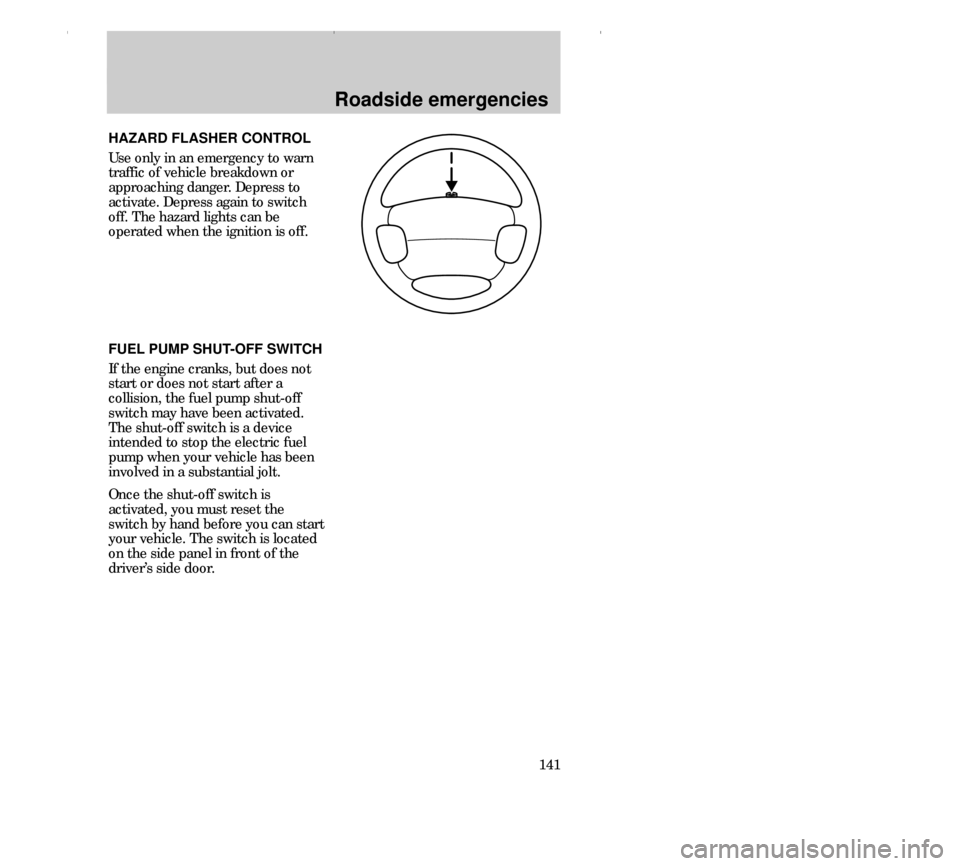
Roadside emergencies
141
HAZARD FLASHER CONTROL
Use only in an emergency to warn
traffic of vehicle breakdown or
approaching danger. Depress to
activate. Depress again to switch
off. The hazard lights can be
operated when the ignition is off.
FUEL PUMP SHUT-OFF SWITCH
If the engine cranks, but does not
start or does not start after a
collision, the fuel pump shut-off
switch may have been activated.
The shut-off switch is a device
intended to stop the electric fuel
pump when your vehicle has been
involved in a substantial jolt.
Once the shut-off switch is
activated, you must reset the
switch by hand before you can start
your vehicle. The switch is located
on the side panel in front of the
driver’s side door.
22CDren 17.6.99 11:09 Uhr Seite 141
Page 142 of 248
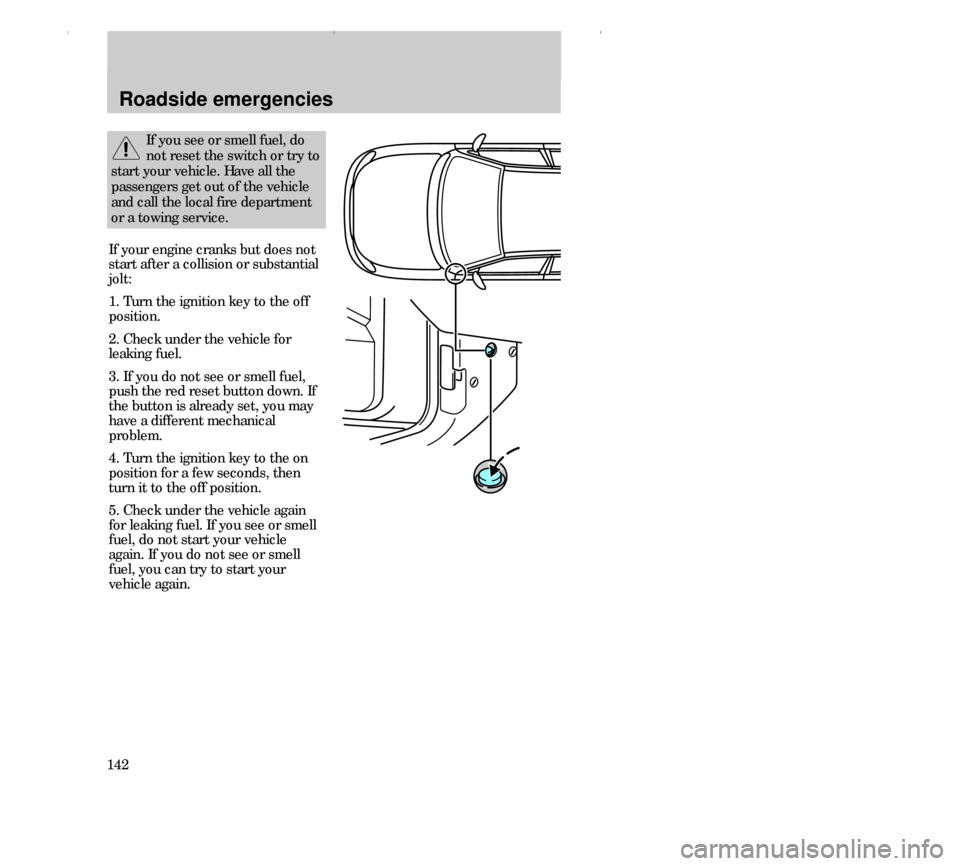
142
Roadside emergencies
If your engine cranks but does not
start after a collision or substantial
jolt:
1. Turn the ignition key to the off
position.
2. Check under the vehicle for
leaking fuel.
3. If you do not see or smell fuel,
push the red reset button down. If
the button is already set, you may
have a different mechanical
problem.
4. Turn the ignition key to the on
position for a few seconds, then
turn it to the off position.
5. Check under the vehicle again
for leaking fuel. If you see or smell
fuel, do not start your vehicle
again. If you do not see or smell
fuel, you can try to start your
vehicle again.
If you see or smell fuel, do
not reset the switch or try to
start your vehicle. Have all the
passengers get out of the vehicle
and call the local fire department
or a towing service.
23CREen 17.6.99 11:11 Uhr Seite 142
Page 143 of 248
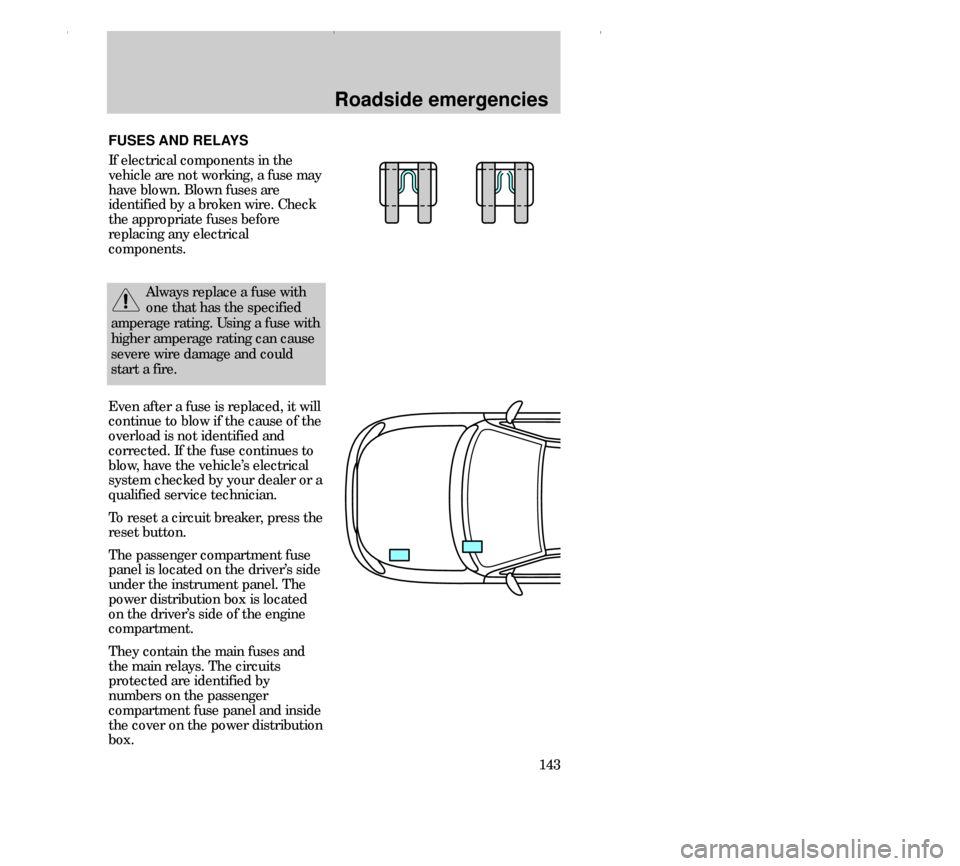
Roadside emergencies
143 Even after a fuse is replaced, it will
continue to blow if the cause of the
overload is not identified and
corrected. If the fuse continues to
blow, have the vehicle’s electrical
system checked by your dealer or a
qualified service technician.
To reset a circuit breaker, press the
reset button.
The passenger compartment fuse
panel is located on the driver’s side
under the instrument panel. The
power distribution box is located
on the driver’s side of the engine
compartment.
They contain the main fuses and
the main relays. The circuits
protected are identified by
numbers on the passenger
compartment fuse panel and inside
the cover on the power distribution
box.
FUSES AND RELAYS
If electrical components in the
vehicle are not working, a fuse may
have blown. Blown fuses are
identified by a broken wire. Check
the appropriate fuses before
replacing any electrical
components.
Always replace a fuse with
one that has the specified
amperage rating. Using a fuse with
higher amperage rating can cause
severe wire damage and could
start a fire.
23CREen 17.6.99 11:11 Uhr Seite 143
Page 144 of 248
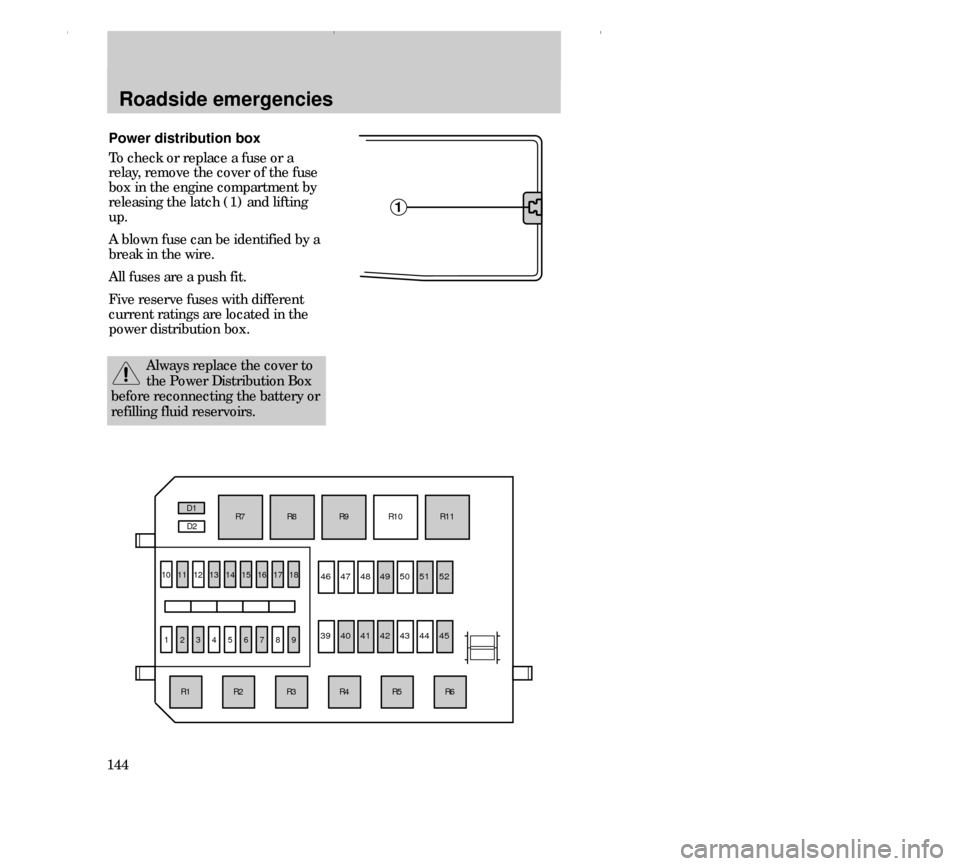
Roadside emergencies
144
1
111213141516
R6R5R4R3R2
10
123456789
R1R7R8
R9R10
R11 D1
D2
17
18
4647
4849 5051 52
394041
424344
45
Power distribution box
To check or replace a fuse or a
relay, remove the cover of the fuse
box in the engine compartment by
releasing the latch (1) and lifting
up.
A blown fuse can be identified by a
break in the wire.
All fuses are a push fit.
Five reserve fuses with different
current ratings are located in the
power distribution box.
Always replace the cover to
the Power Distribution Box
before reconnecting the battery or
refilling fluid reservoirs.
23CREen 17.6.99 11:11 Uhr Seite 144
Page 145 of 248
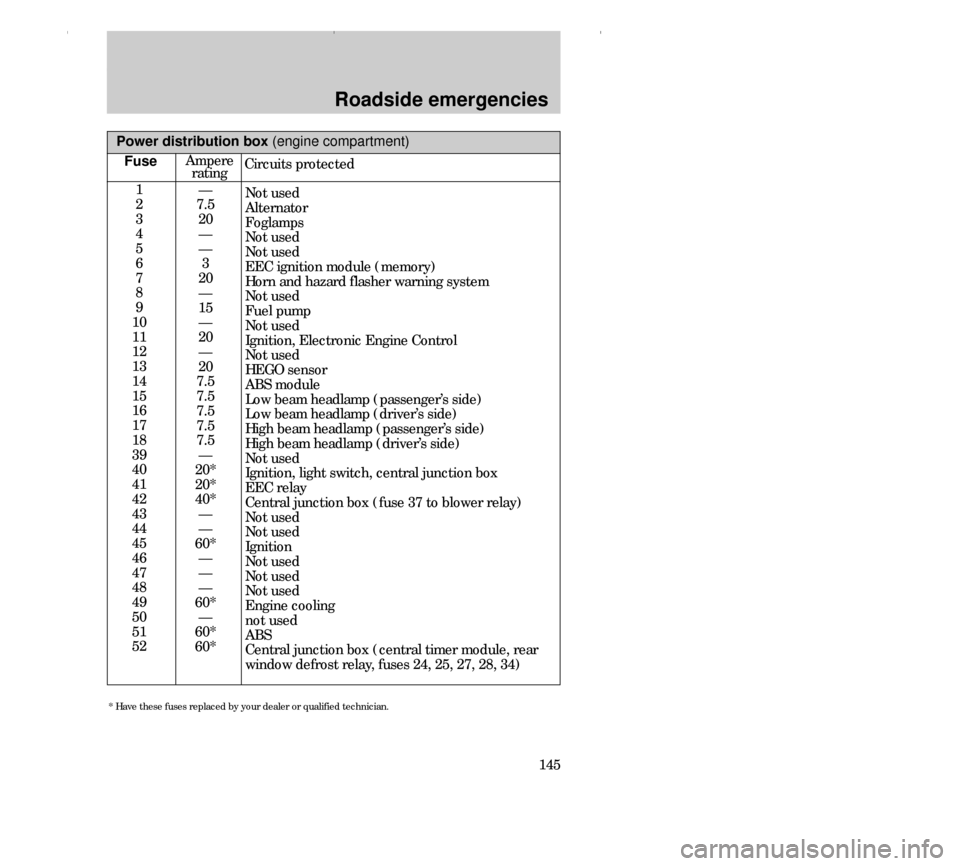
Roadside emergencies
145 Ampere
ratingCircuits protected
1
2
3
4
5
6
7
8
9
10
11
12
13
14
15
16
17
18
39
40
41
42
43
44
45
46
47
48
49
50
51
52—
7.5
20
—
—
3
20
—
15
—
20
—
20
7.5
7.5
7.5
7.5
7.5
—
20*
20*
40*
—
—
60*
—
—
—
60*
—
60*
60*Not used
Alternator
Foglamps
Not used
Not used
EEC ignition module (memory)
Horn and hazard flasher warning system
Not used
Fuel pump
Not used
Ignition, Electronic Engine Control
Not used
HEGO sensor
ABS module
Low beam headlamp (passenger’s side)
Low beam headlamp (driver’s side)
High beam headlamp (passenger’s side)
High beam headlamp (driver’s side)
Not used
Ignition, light switch, central junction box
EEC relay
Central junction box (fuse 37 to blower relay)
Not used
Not used
Ignition
Not used
Not used
Not used
Engine cooling
not used
ABS
Central junction box (central timer module, rear
window defrost relay, fuses 24, 25, 27, 28, 34) Fuse
Power distribution box (engine compartment)
* Have these fuses replaced by your dealer or qualified technician.
23CREen 17.6.99 11:11 Uhr Seite 145
Page 146 of 248
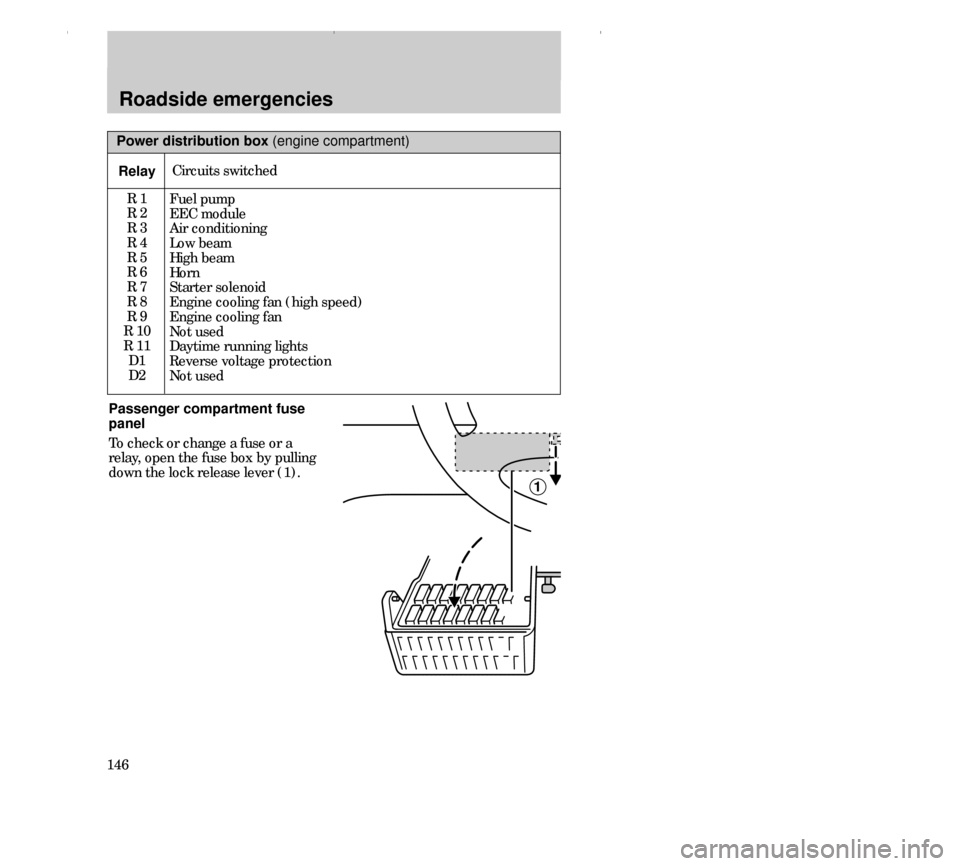
Roadside emergencies
146
Power distribution box (engine compartment)
RelayCircuits switched
R 1
R 2
R 3
R 4
R 5
R 6
R 7
R 8
R 9
R 10
R 11
D1
D2
Passenger compartment fuse
panel
To check or change a fuse or a
relay, open the fuse box by pulling
down the lock release lever (1).
1
Fuel pump
EEC module
Air conditioning
Low beam
High beam
Horn
Starter solenoid
Engine cooling fan (high speed)
Engine cooling fan
Not used
Daytime running lights
Reverse voltage protection
Not used
23CREen 17.6.99 11:11 Uhr Seite 146
Page 147 of 248
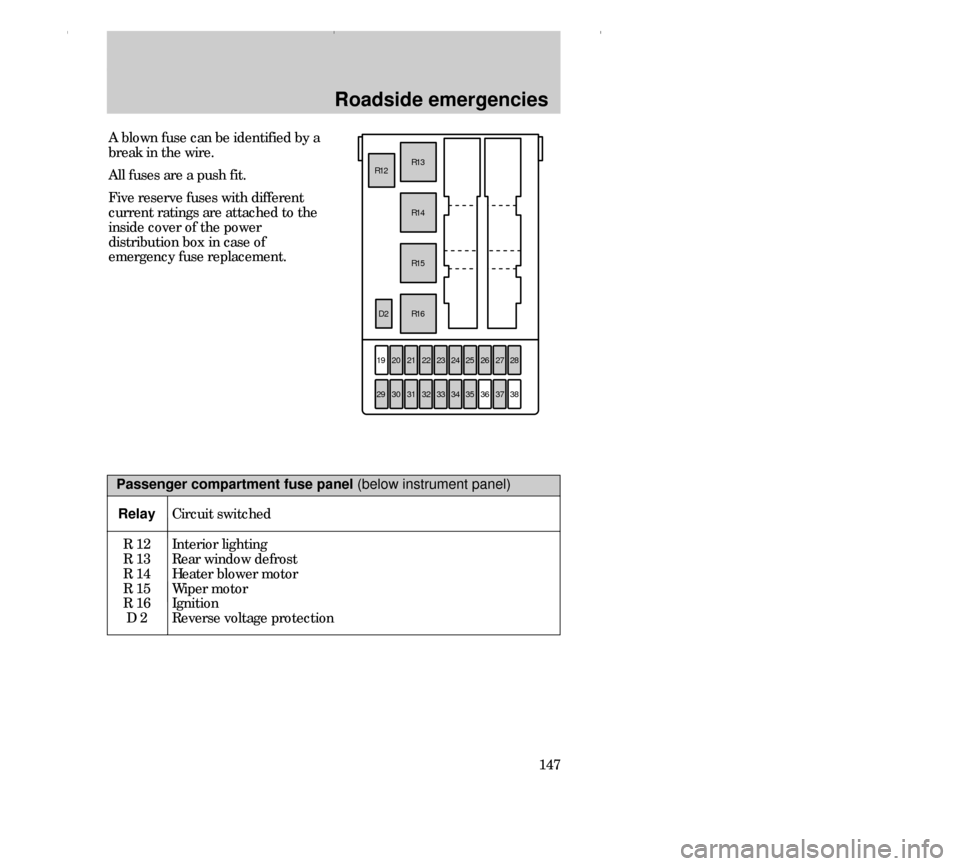
Roadside emergencies
147 A blown fuse can be identified by a
break in the wire.
All fuses are a push fit.
Five reserve fuses with different
current ratings are attached to the
inside cover of the power
distribution box in case of
emergency fuse replacement.
19 20 21R16 R15
R14 R12R13
22 23 24 25 26 27 28
29 30 31 32 33 34 35 36 37 38
D2
Passenger compartment fuse panel (below instrument panel)
Relay
Circuit switched
R 12
R 13
R 14
R 15
R 16
D 2Interior lighting
Rear window defrost
Heater blower motor
Wiper motor
Ignition
Reverse voltage protection
23CREen 17.6.99 11:11 Uhr Seite 147
Page 148 of 248

Roadside emergencies
148
19
20
21
22
23
24
25
26
27
28
29
30
31
32
33
34
35
36
37
38—
C10
40
—
15
15
20
7.5
15
30
30
7.5
7.5
7.5
7.5
7.5
7.5
—
30
—Not used
Wiper motors (circuit breaker)
Power windows
Not used
Backup lamps
Brake lamps
Door locks
Main light
Cigar lighter
Electric seats
Rear window defrost
Engine management system
Instrument panel illumination
Radio
Parking lamps - driver’s side
Interior lighting/electric mirror
adjustment
Parking lamps - passenger’s side
Not used
Heater blower motor
Not used
Passenger compartment fuse panel (below instrument panel)
FuseAmpere
ratingCircuits protected
23CREen 17.6.99 11:11 Uhr Seite 148
Page 149 of 248
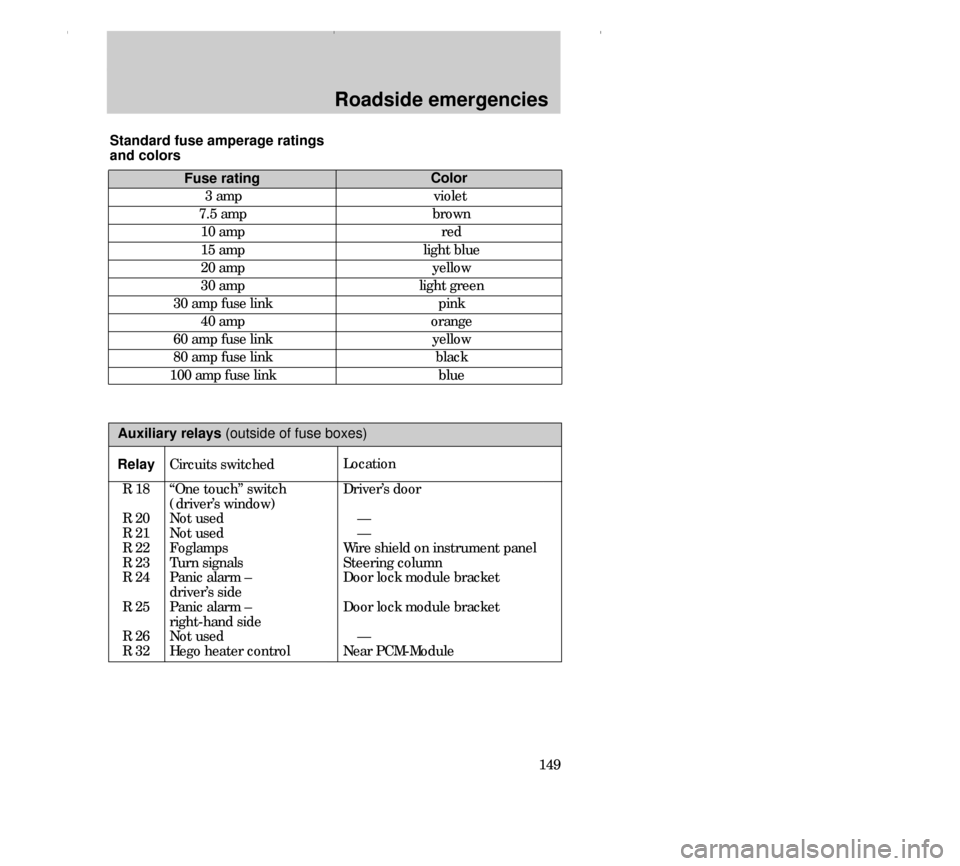
Roadside emergencies
149
Fuse rating
7.5 amp
10 amp
15 amp
20 amp
30 amp
30 amp fuse link
40 amp
60 amp fuse link
80 amp fuse link
100 amp fuse linkColor
brown
red
light blue
yellow
light green
pink
orange
yellow
black
blue
Relay
R 18
R 20
R 21
R 22
R 23
R 24
R 25
R 26
R 32
“One touch” switch
(driver’s window)
Not used
Not used
Foglamps
Turn signals
Panic alarm –
driver’s side
Panic alarm –
right-hand side
Not used
Hego heater controlDriver’s door
—
—
Wire shield on instrument panel
Steering column
Door lock module bracket
Door lock module bracket
—
Near PCM-Module
Circuits switchedLocation Standard fuse amperage ratings
and colors
3 amp violet
Auxiliary relays (outside of fuse boxes)
23CREen 17.6.99 11:11 Uhr Seite 149
Page 150 of 248
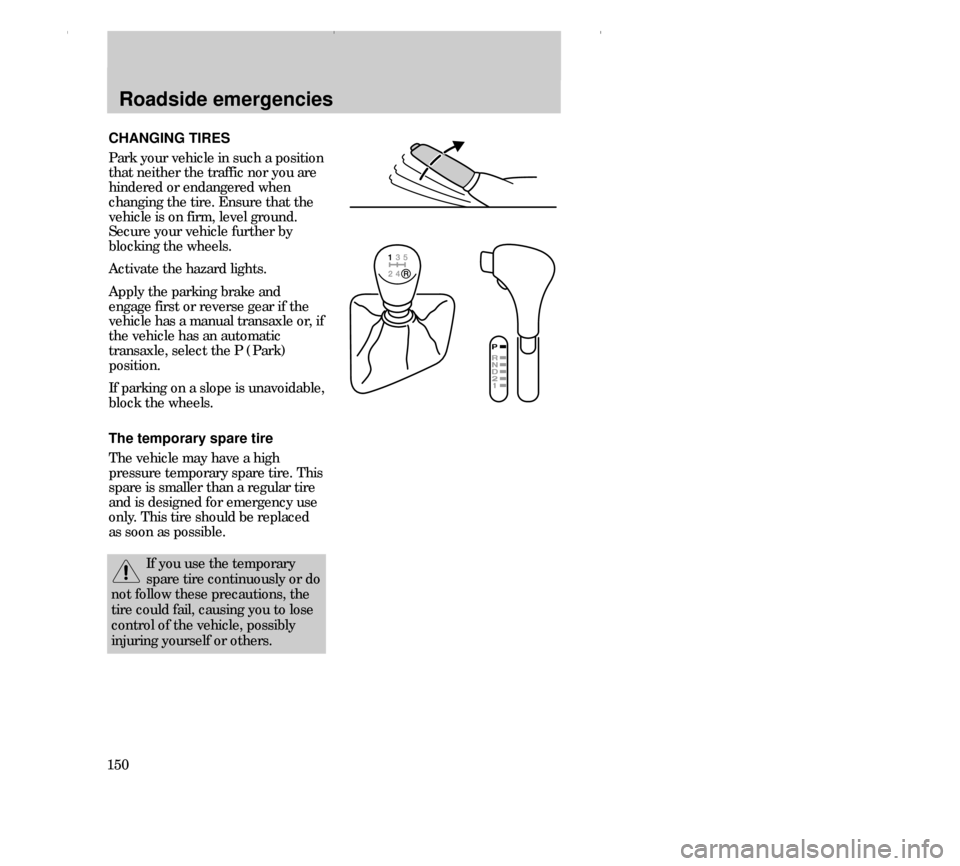
Roadside emergencies
150
CHANGING TIRES
Park your vehicle in such a position
that neither the traffic nor you are
hindered or endangered when
changing the tire. Ensure that the
vehicle is on firm, level ground.
Secure your vehicle further by
blocking the wheels.
Activate the hazard lights.
Apply the parking brake and
engage first or reverse gear if the
vehicle has a manual transaxle or, if
the vehicle has an automatic
transaxle, select the P (Park)
position.
If parking on a slope is unavoidable,
block the wheels.
The temporary spare tire
The vehicle may have a high
pressure temporary spare tire. This
spare is smaller than a regular tire
and is designed for emergency use
only. This tire should be replaced
as soon as possible.
If you use the temporary
spare tire continuously or do
not follow these precautions, the
tire could fail, causing you to lose
control of the vehicle, possibly
injuring yourself or others.
23CREen 17.6.99 11:11 Uhr Seite 150